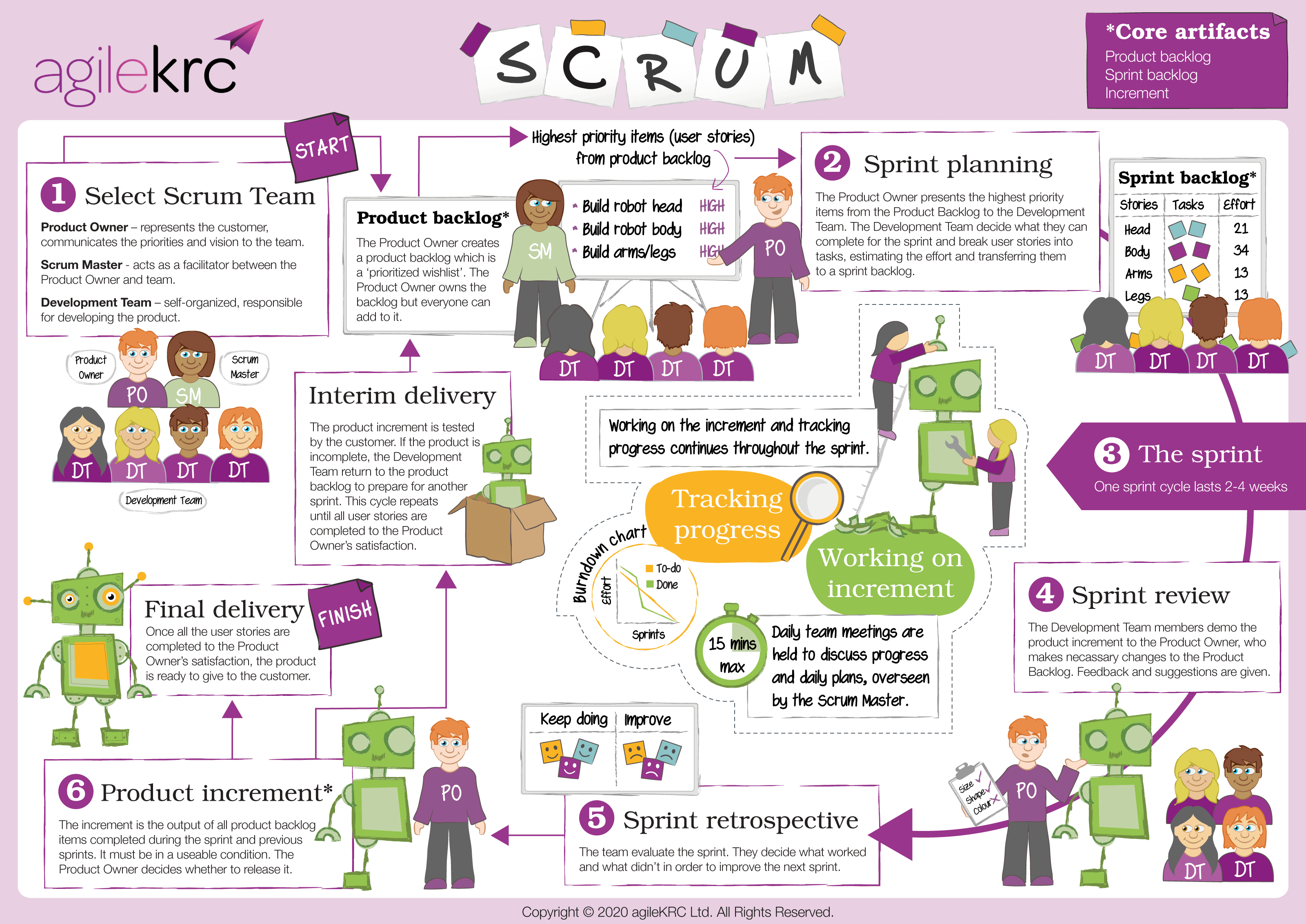
Introduction
Scrum is an agile delivery method that helps develop, deliver, and sustain complex projects. Contrary to popular belief, Scrum is not a project management method.
Scrum is an agile methodology that is lightweight, simple to understand, but difficult to master. That’s why it is recommended to get the best out of Scrum, developers take a Scrum course.
Scrum emphasizes teamwork, collaboration, and continuous improvement. It provides a structure for teams to work together to deliver high-quality software products, while also promoting flexibility and adaptability in the face of changing requirements.
Read on to find out about the three main components of the Scrum framework: Scrum team roles, Scrum events, and Scrum artifacts.
Scrum team roles
There are three primary roles within a Scrum team: the Scrum Master, the Product Owner, and the Developers.
- Scrum Master – The Scrum Master is the facilitator of the Scrum process. They ensure that the team is following the Scrum framework, remove any impediments that may be blocking the team, and help the team to continuously improve their processes. Contrary to what some people may argue, a Scrum Master is not a project manager. Scrum expects the whole Scrum team to be self-organising, and not be commanded by a project manager in the form of the Scrum Master.
- Product Owner – The Product Owner is responsible for defining and prioritizing the features and requirements for the product. They are the voice of the customer and work closely with the development team to ensure that the product meets the needs of the customer.
- Developers – The Developers are responsible for developing and delivering the product. They work together as a team to create high-quality software that meets the requirements defined by the Product Owner.
Scrum events
There are five primary events within the Scrum framework: Sprint Planning, Daily Scrum, Sprint Review, Sprint Retrospective, and the Sprint itself.
- Sprint Planning – At the beginning of each Sprint, the Scrum team holds a Sprint Planning meeting to define the Sprint Goal and to plan the work for the upcoming Sprint. The team works together to create a Sprint Backlog, which is a list of items from the Product Backlog that they plan to complete during the Sprint.
- Daily Scrum – The Daily Scrum is a 15-minute meeting that the Scrum team holds every day to discuss progress and plan the day ahead. The team members answer three questions: What did I do yesterday? What will I do today? Is there anything blocking me?
- Sprint Review – At the end of each Sprint, the Scrum team holds a Sprint Review meeting to present the work they have completed to the stakeholders. The team demonstrates the product increment and receives feedback from the stakeholders.
- Sprint Retrospective – After the Sprint Review, the Scrum team holds a Sprint Retrospective meeting to reflect on the previous Sprint and to identify areas for improvement. The team works together to create an action plan to address any issues that were identified.
- Sprint – The Sprint is a time-boxed period during which the Scrum team works to complete the items from the Sprint Backlog. The Sprint is typically 2-4 weeks long, and at the end of the Sprint, the team delivers a potentially releasable product increment.
Scrum artifacts
There are several Scrum artifacts that are used to support the Scrum process. These include the Product Vision, Product Backlog, Sprint Goal, Sprint Backlog, Definition of Done (DoD), and the Product Increment.
- Product Vision – The Product Vision is a high-level description of the product that the Scrum team is building. It provides a clear and concise statement of the product’s goals, objectives, and target users.
- Product Backlog – The Product Backlog is a list of all the features, requirements, and tasks that need to be completed for the project. The Product Backlog is prioritized by the Product Owner and is used to guide the work of the development team.
- Sprint Goal – The Sprint Goal is a statement of what the team plans to achieve during the Sprint. It is a clear and concise statement of the Sprint objective and helps to guide the team’s work.
- Sprint Backlog – The Sprint Backlog is a list of items from the Product Back log that the team has committed to completing during the Sprint. It is created during the Sprint Planning meeting and is used to guide the team’s work throughout the Sprint.
- Definition of Done (DoD) – The Definition of Done is a shared understanding of what it means for a task or feature to be considered complete. The DoD defines the criteria that must be met for a task to be considered “done” and ready for release.
- Product Increment – The Product Increment is the sum of all the completed items in the Product Backlog. At the end of each Sprint, the team delivers a potentially releasable Product Increment that has been tested and meets the Definition of Done.
Why use Scrum?
Scrum offers several benefits to software development teams, including:
- Increased collaboration – Scrum emphasizes collaboration and teamwork, which helps to build stronger and more productive teams.
- Flexibility and adaptability – Scrum is designed to be flexible and adaptable, which allows teams to respond quickly to changing requirements or priorities.
- Transparency – Scrum promotes transparency, with regular meetings and updates that keep everyone on the same page.
- Increased quality – Scrum focuses on delivering high-quality products, with regular testing and reviews throughout the development process.
- Faster time-to-market – By breaking work down into smaller, more manageable chunks, Scrum helps teams to deliver products faster and more frequently.
Summary
Scrum is an Agile framework for software development that provides a structure for teams to work together to deliver high-quality products. Scrum consists of three main components: Scrum team roles, Scrum events, and Scrum artifacts.
Scrum offers several benefits to software development teams, including increased collaboration, flexibility, transparency, increased quality, and faster time-to-market.
Infographic

agileKRC has helped shape agile thinking by leading the teams that developed AgilePM® and PRINCE2 Agile®. We take a practical, success-oriented approach. We begin by taking the time to listen and understand your needs, before offering our real-world experience and expert guidance.

